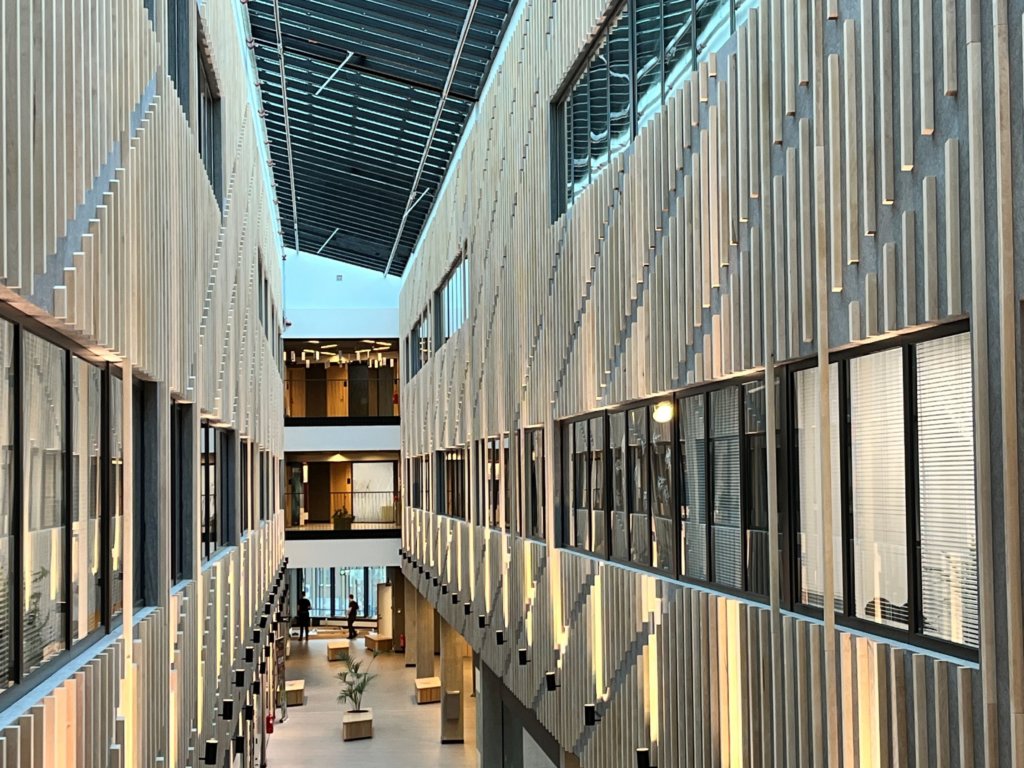The city as an open innovation platform?
What would Tartu do? Discover the Estonian city’s secret to facilitating the growth of digital start-ups and other new businesses
How can a public body like a local authority be innovative – especially when there are limited in-house human and financial resources? Béla Kézy, urban development specialist and member of the TechPlace team, takes us to the dynamic Estonian city of Tartu for inspiration…

Tartu is the second largest city in Estonia. With its 95 000 inhabitants, though, it can only be considered a medium-sized town. Still, it has lots of state-of-the art digital businesses, a vibrant startup community, and has nurtured more unicorns than most larger cities can claim.
If you spend some time in Tartu, you can immediately feel that the city is lively, constantly on the move – people populate the streets and there’s a wide range of restaurants and pubs. At the same time, the city somehow also managed to retain its small-town charm – a place where it is good to live and where you can really belong.
What could be the secret?
The wider context: e-Estonia
Estonia declared itself an independent state for the second time in its history in August 1991, regaining its independence after being part of the Soviet Union for a long period. Practically, a new state needed to be built – definitely not an easy task…
The people of Estonia and the political parties, however, saw this as an opportunity rather than as an obstacle. Building something from scratch also means that you can learn from others, leapfrog certain phases, and have a chance to do it right the first time. And, given that the country did not have an abundance of natural resources, they invested in human capital and digitalization from the start. The main argument for digitalization was that it accelerates the development of effective governance and administrative structures,and helps to streamline bureaucratic processes, while also saving money and time for the citizens.
This commitment to digital is well reflected in the “digital by default” principle: it means that public authorities have to offer the full portfolio of their services online, in a digital format, and steps need to be taken to make this the norm and not the exception. It is important, though, that people are not forced in any way to use the online versions of public services – they simply do because it is better, cheaper and quicker.
Today digital is part of everyday life in Estonia: the country has mobile parking since 2000, e-ID since 2002, and even I-voting was introduced as early as in 2005 – just to name a few.
Estonia has even offered global e-Residency since 2014: anyone from any part of the world can easily become an Estonian e-Resident. And they do: today Estonia has 70 000+ e-Residents from 160 countries. It is perfect for people who intend to set up a business – and this is well reflected in the fact that by now over 13 000 companies have been created by e-Residents in Estonia.
Today, Estonia is also among the countries hosting the highest concentration of start-ups per capita. And it’s easy to see why. From starting your business and declaring taxes to filing annual reports, you can do effectively anything without leaving the comfort of your couch. No surprise, then – where it is easy to do business, business will develop.
Building a world-class e-Government and digital economy requires educated people, and Estonians are aware that raising smarter kids is the best investment any country can make. Estonia has also learnt that having an abundance of smart people can more than compensate for the lack of natural resources in today’s knowledge-based economy. With this in mind, Estonia aims to incorporate the latest digital technology in learning and teaching in order to improve the digital skills of the entire nation. Digital education starts from an early age – and the effectiveness of Estonian education is reflected in the fact that the country ranks first in the OECD’s PISA (Programme for International Student Assessment) tests in Europe. Besides, quality education is available not only for the kids: Estonia is pursuing a lifelong learning strategy – a wide range of (very often free) IT courses are offered by both public and private sector companies to interested citizens of any age.
Tartu: the city as an open innovation platform
Having such a national environment certainly helps – but it is far from being a guarantee for success. Without a clear vision, openness and an innovation mindset, Tartu could not have become what it is today.
But how can a bureaucratic public body like a local authority be innovative – especially when there are limited in-house human and financial resources? The city of Tartu has opted for a collaborative and co-creative strategy – working together with the private sector, universities, and other municipalities to make innovation happen.
To facilitate the development of digital, and other, businesses – especially start-ups – the local authority has three key roles:
- Enabler: Initiate the creation of a business development ecosystem – one that works together in a harmonised way to support local businesses at all stages of their development. The Tartu business development ecosystem incorporates a wide range of organisations and support programmes – including the Tartu Science Park, a Gaming and Film Incubator, the university’s spin-off programme, the Tartu Business Advisory Services, and the BuildIT hardware acceleration programme – just to name a few.
- Steward: Understand the needs of businesses and create, maintain and constantly develop an attractive and friendly environment meeting those needs. Apparently, Tartu is succeeding. As Martin Vares, CEO of Fractory.co on-demand manufacturing platform said in an interview: “In Estonia, you may not meet Zuckerberg at the café, but there’s a great possibility that you’ll meet the next Zuckerberg here…. I think that Tartu is a good place for business. It’s a great environment for starting and already operating companies because it’s much quieter than what’s happening inside the entrepreneur’s head.”
- Innovator and test-bed: First customer and supporting partner for start-ups desperate to test their solutions in real-world environment.
Many city leaders – especially in Central-Eastern Europe – still think that local authorities are not meant to innovate. However, the example of Tartu proves otherwise. According to Raimond Tamm, Deputy Mayor of Tartu, the municipality itself should also have a ‘startup’ (or, as they like to put, sTARTUp) mindset: flexible and agile, taking calculated risks. He believes there are various ways a city can innovate:
- by purchasing services instead of products, the city can facilitate innovation even through regular procurements;
- cities can also use what Tamm calls ‘innovation procurement’: identify a challenge and then bring in a partner to find a solution together;
- by being a testbed for new ideas: start-ups – even with potentially brilliant solutions – often struggle to find a first customer, a place where they can try their product or service in real-life circumstances.
And that’s exactly what Tartu is offering to interested start-up businesses – access to certain data the local authority has, or public spaces to test their solution, even providing feedback and contributing to product/service development. This is good for the business – but it is also potentially good for the city. If the partnership works out and the experiment is successful, on the one hand the city can solve a local challenge, on the other hand a start-up with a growth potential is likely to settle in Tartu, create new jobs and pay tax there.
Exactly this “city as an open innovation platform” approach was used for instance when completely redesigning the public transport system of the city in 2019: the local authority set the goals, defined the parameters and then collaborated with companies to establish a more citizen-friendly public transport service.
Despite occasional failures, the city remains committed to continue this approach while addressing city challenges.
Interview with Deputy Mayor, conducted by Béla Kézy
Delta Sandbox: using design thinking to solve real-world challenges
Tartu is a university city with 18 000 students, a wide range of research and education facilities. The university is an important player in the local ecosystem, and it has built an active and living relationship with the local authority, with businesses and other organisations.
A great example of city-university cooperation is Delta Sandbox. It is a design thinking and digital product management programme for master students at the university, offering a creative study and work environment.

Delta Sandbox provides its students real-life experience through its industry cooperation programme. As part of the initiative any business, or public organisation, can bring a problem statement, and a selected group of students with the support of a mentor from the university works together with the organisation to find a solution. The team uses the design thinking approach, and the outcome of the collaboration is a prototype of the jointly identified digital product. The initiative is a win-win for the students and cooperating businesses and organisations. Students can obtain new digital product management skills through real-life projects, learn how to work in teams, and meet potential employers. Businesses, on the other hand, can improve their visibility, learn new methods and have better, more direct access to talent, while also perhaps identifying an innovative solution to an existing problem.
Example of Delta Sandbox – local authority cooperation
One of the challenges the local authority approached Delta Sandbox with was focused on talent retention. Many of the students of Tartu University are residents of other cities – and most of them are just studying there, but are not actively involved in city life, don’t register as Tartu citizens. The local authority, however, would like to engage them, encourage them to participate more actively and register as permanent or temporary citizens – and maybe even decide not to leave Tartu after their studies.
So, the following challenge was presented:
“How to involve and engage young people to the city they live permanently or temporarily? How to have them register as citizens?”
During one semester, the student team appointed by Delta Center and the relevant staff members from the local authority worked together to better understand the problem and identify a solution. In the end, the wireframe prototype of a Citizen Participation App was developed. Anyone registered as a Tartu citizen can participate in various surveys, suggest development projects and vote for ideas, and through active participation can earn Tartu Tokens. Tartu Tokens then can be used to have a free ride with a shared bike, enter museum free, get discounts in the municipal swimming pool, etc.
Interview with Eveli and Maria, conducted by Béla Kézy
What can cities learn from Tartu?
Not all cities – especially in Central-Eastern Europe – has the unique supporting and inspiring digital environment of Estonia. Nevertheless, any city can create better conditions for innovation, start-ups, and digital businesses – and can even become an innovator.
Just like with urban good practices in any other area, however, unfortunately there is no one easy-to-copy magic solution… Instead, there’s hard work, trial and error, and a combination of various actions a local authority can do. While you can learn from others, adapt certain things, the exact steps need to be identified locally by the city, based on the local circumstances, the strengths, and available resources. As Tartu’s example shows, though, local authorities are not alone in that process: they can rely on a wide range of local organisations that can become part of a functional local ecosystem.
A final tip from Tartu: The most important, and probably the hardest, part is the mindset: as a local authority, you need to be open to change and collaboration with others; you need to be agile and flexible, ready to share, take calculated risks – and yes, even to fail from time-to-time.

